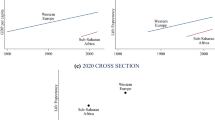Abstract
This article discuss Gordon Tullock’s contributions to bioeconomics: His contributions to the bioeconomics of non-human societies, his impact on second and third generation bioeconomists, and the founding of the Journal of Bioeconomics.
Similar content being viewed by others
References
Becker, G. S. (1976). Altruism, egoism, and genetic fitness. Economics and sociobiology. Journal of Economic Literature, 14(3), 817–826.
Bergstrom, C. T., & Bergstrom, T. C. (1999). Does mother nature punish rotten kids? Journal of Bioeconomics, 1(1), 47–72.
Buchanan, J. M. (2000). Group selection and team sports. Journal of Bioeconomics, 2(1), 1–7.
Cassill, D. (2003). Skew selection: nature favors a trickle-down distribution of resources in ants. Journal of Bioeconomics, 5(2 & 3), 83–96.
Charnov, E. (1976). Optimal foraging: the marginal value theorem. Theoretical Population Biology, 9, 129–136.
Charnov, E. (1990). The economy of nature and the nature of economics. Unpublished manuscript.
Cordes, C. (2004). The human adaptation for culture and its behaviorial implications. Journal of Bioeconomics, 6(2), 143–163.
Corning, P. A. (2000). Biological adaptation in human species: a “basic needs” approach. Journal of Bioeconomics, 2(1), 41–86.
Demsetz, H. (2009). Seemingly altruistic behavior: selfish genes or cooperative organisms. Journal of Bioeconomics, 11(3), 211–221.
Emlen, J. M. (1966). The role of time and energy in food preference. American Naturalist, 101, 385–389.
Gibb, J. (1958). Predation by tits and squirrels on the eucosmid Ernarmonie conicolana. Journal of Animal Ecology, 27, 375–396.
Ghiselin, M. T. (1999). Progress and the economy of nature. Journal of Bioeconomics, 1(1), 35–45.
Ghiselin, M. T. (2005). Comments on Robert Yarbrough’s ‘teaching bioeconomics’. Journal of Bioeconomics, 7(1), 39–40.
Gifford, A. Jr. (1999). Being and time: on the nature and the evolution of institutions. Journal of Bioeconomics, 1(2), 127–149.
Gowdy, J. (2006). Evolutionary theory and economic policy with reference to sustainability. Journal of Bioeconomics, 8(1), 1–19.
Hirshleifer, J. (1999). There are many evolutionary pathways to cooperation. Journal of Bioeconomics, 1(1), 73–93.
Hodgson, G. (2007). Taxonomizing the relationship between biology and economics: a very long engagement. Journal of Bioeconomics, 9(2), 169–185.
Lack, D. (1966). Population studies of birds. Oxford: Oxford University Press.
Landa, J. T. (1986). The political economy of swarming in honeybees: voting-with-the wings, decision-making costs, and the unanimity rule. Public Choice, 51, 25–38.
Landa, J. T. (1999). Bioeconomics of some nonhuman and human societies: new institutional economics approach. Journal of Bioeconomics, 1(1), 95–113.
Landa, J. T. (2008). The bioeconomics of homogeneous middleman groups as adaptive units: theory and empirical evidence from a group selection framework. J. T. Landa & D. S. Wilson (Eds.), Special issue: Group selection: theory and evidence. Journal of Bioeconomics, 10(3), 259–278.
Landa, J. T. (2009). Editor-in-Chief’s farewell: editing the Journal of Bioeconomics, 1999–2009. Journal of Bioeconomics, 11(3), 207–210.
Landa, J. T., & Ghiselin, M. T. (1999). The emerging discipline of bioeconomics: aims and scope of the Journal of Bioeconomics. Journal of Bioeconomics, 1(1), 5–12.
Landa, J. T., & Tullock, G. (2003). Why ants do but honeybees do not construct satellite nests. Journal of Bioeconomics, 5(2 & 3), 151–164.
Landa, J. T., & Wallis, A. (1988). Socio-economic organization of honeybee colonies. Journal of Social and Biological Structures, 2, 353–363.
McArthur, R. H., & Pianka, E. R. (1966). On optimal use of a patchy environment. American Naturalist, 100, 603–609.
Metcalfe, J. S. (2002). On the optimality of the competitive process: Kimura’s theorem and market dynamics. Journal of Bioeconomics, 4(2), 109–133.
Parker, G. A. (2006). Behavioural ecology: natural history as science. In J. R. Lucas & L. W. Simmons (Eds.), Essays in animal behaviour. Celebrating 50 years of animal behaviour (pp. 23–56). Burlington: Elsevier.
Pryor, F. (2003). What does it mean to be human? A comparison of primate economies. Journal of Bioeconomics, 5(2 & 3), 97–146.
Rubin, P. H. (2000). Group selection and the limits to altruism. Journal of Bioeconomics, 2(1), 9–23.
Tullock, G. (1971). The coal tit as a careful shopper. American Naturalist, 105(941), 77–80.
Tullock, G. (1977). Economics and sociobiology: a comment. Journal of Economic Literature, 15(2), 502–506.
Tullock, G. (1993). The economics of non-human societies. Tucson: Pallas Press.
Tullock, G. (1999). Some personal reflections on the history of bioeconomics. Journal of Bioeconomics, 1(1), 13–18.
Vermeij, G. J. (2009). Comparative economics: evolution and the modern economy. Journal of Bioeconomics, 11(2), 105–134.
Vromen, J. (2010). Allusions to evolution: edifying evolutionary biology rather than economic theory. In R. van Horn, P. Mirowski & T. Stapleford (Eds.), Building Chicago economics: new perspectives on the history of America’s most powerful economics program (pp. 208–236). Cambridge: Cambridge University Press.
Wilson, E. O. (1998). Consilience: the unity of knowledge. New York: Alfred A. Knoff.
Wilson, D. S., & Wilson, E. O. (2007). Rethinking the theoretical foundation of sociobiology. Quarterly Review of Biology, 82(4), 328–348.
Witt, U. (1999). Bioeconomics as economics from a Darwinian perspective. Journal of Bioeconomics, 1(1), 19–34.
Yarbrough, B. V., & Yarbrough, R. M. (1999). Governance structures, insider status, and boundary maintenance. Journal of Bioeconomics, 1(3), 289–310.
Yarbrough, R. M., (2005). Teaching bioeconomics. Journal of Bioeconomics, 7(1), 1–38.
Zak, P. J., & Park, K. W. (2002). Population genetics and economic growth. Journal of Bioeconomics, 4(1), 1–37.
Author information
Authors and Affiliations
Corresponding author
Rights and permissions
About this article
Cite this article
Landa, J.T. Gordon Tullock’s contributions to bioeconomics. Public Choice 152, 203–210 (2012). https://doi.org/10.1007/s11127-011-9855-2
Received:
Accepted:
Published:
Issue Date:
DOI: https://doi.org/10.1007/s11127-011-9855-2




